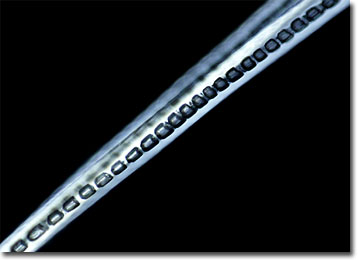Polarized Light Microscopy Digital Image Gallery
Angora Rabbit Wool
The Angora rabbit is the variety most commonly raised for wool production. The fiber generated by the longhaired animals is soft, fine, and much warmer than sheep’s wool.

View a second image of Angora Rabbit Wool
Angora rabbits are sometimes said to have originated in the Ankara region of Turkey, but little evidence supports this claim. The rabbits may have only received their moniker because of the remarkable similarity between their hair and that of the Angora goat, which is also often alleged to have been initially developed through selective breeding in that region. The first Angora rabbit did not appear in England until the late 1700s, when they began being raised there in order that their luxurious wool could be spun into yarn for clothing solely worn by nobility. The beautiful, gentle-tempered animals soon became pets for the wealthy as well, and were eventually brought to the United States sometime following the First World War. Today, the animals continue to serve the dual purpose of pets and wool producers in various locations around the world, but are most popular in France and England.
The hair of the Angora rabbit is typically allowed to grow three or more inches long before it is clipped, sheared, or plucked. These hair removal processes generally cause no harm to the animals and are carried out four times each year. The total annual yield for a single Angora rabbit ranges from 7 to 14 ounces, which may be spun into enough yarn to construct one small garment, such as a short-sleeved sweater. Items composed of Angora rabbit wool are usually of high quality and tend to have a very nice feel against the skin. Indeed, many people who find garments made of sheep’s wool scratchy and uncomfortable find Angora wool to be a surprisingly cozy alternative.
